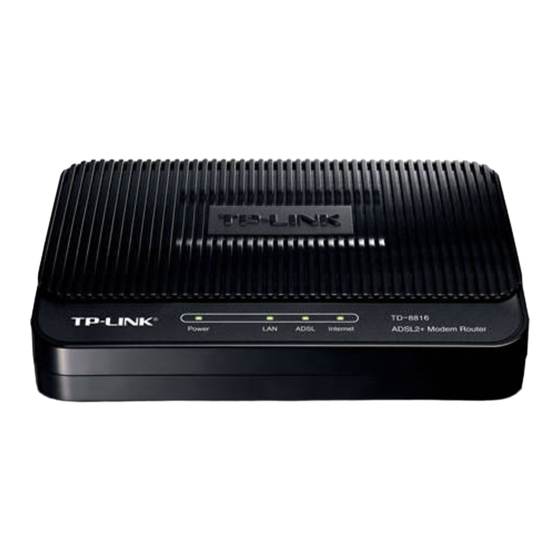Advertisement
Quick Links
Download this manual
See also:
User Manual
Before you disconnect any existing ISP gear, please read this initial section carefully, as there is information
we need from the existing deployment.
There are two forms of DSL login, the most common is PPPoE and Windstream exclusively uses this for
DSL. TDS uses two different approaches, one supports PPPoE and the other uses DHCP.
All the PPPoE cases require that you know your ISP-provided credentials.
Windstream, this is your user@windstream.net and an ISP-provided PPPoE password
TDS, this your current user@tds.net email address and current email password.
For TDS users, here's how you determine if you are on a DHCP link.
•
Log into your current TDS router by going to 192.168.0.1 with a browser
•
Click on Connection status and you will get a display that look like this:
•
If the ISP Protocol says "1483 via DHCP", then you must use DHCP as the connection style in steps 20
& 21.
Before we start, please execute a speed test on the old gear so we have a good record of the 'before'
state. Instructions for this start on step 33 on page 13.
Router Set-Up
Page 1
Advertisement

Subscribe to Our Youtube Channel
Summary of Contents for ActionTec GT784WN
- Page 1 Router Set-Up Before you disconnect any existing ISP gear, please read this initial section carefully, as there is information we need from the existing deployment. There are two forms of DSL login, the most common is PPPoE and Windstream exclusively uses this for DSL.
- Page 2 We assume you are replacing existing ISP-supplied equipment, so we start with removing that first. Power off your existing ISP router / modem Make note of which wires go to which ports on your old gear. Taking several pictures can help make this easy Unbox the TP-Link modem (the small box) Plug your DSL phone-line cable into the...
- Page 3 Connect a laptop via Ethernet cable to one of the LAN ports Alternate via WiFi: • Connect to the ‘evenroute’ access point • WPA2 Security key is ‘FastRouter’ (note: the caps are important) Launch a Browser window and in the URL bar type 192.168.0.1 You will see a prompt for user id and password.
- Page 4 Go to Network → Interfaces to set your ISP information for PPPoE Click the Edit button on the WAN interface Page 4...
- Page 5 If you use PPPoE then follow steps 19 to 21, else skip to page 6: In the ‘PAP/Chap username’ field, enter the user ID your ISP gave you In the PAP/Chap password’ field, enter the password your ISP gave you Click the “Save and Apply”...
- Page 6 If you are a TDS user with DHCP, follow steps A to F: Since we need to use DHCP, we must change the ‘Protocol’ drop-down to DHCP. Click ‘Save & Apply’ button This is what it looks like once you are done: Page 6...
- Page 7 Click on Advanced Settings, and it should look like this: Page 7...
- Page 8 Click on Physical settings and ensure that the eth0.2 interface is chosen, it should look like this: Click on the Firewall setting to make sure the Wan zone is assigned to this, it should look like this: Click ‘Save & Done’ Continue with step 22 on next page.
- Page 9 Now go to Network → SQM / QOS to set your upload and download speeds. This is critical to get right, so don’t skip this step • For 12Mbps service, start with a value of 10200 • For 6Mbps DSL service, start with a value of 5200 •...
- Page 10 Note: If you have many WiFi connected devices like WiFi printers or set top boxes that are hard to reconfigure, you can save yourself a lot of time by making the WiFi settings on this new router mimic the ones from your old router. Just enter your existing SSID into the ESSID field shown in the screen shot for step 28.
- Page 11 Click on the ‘Wireless Security’ link to go to the setting for the security key Page 11...
- Page 12 In the ‘key’ field, type a key phrase you’d like to use (rember people will be typing this in on mobiles and such) Click ‘Save and Apply’ Click on the ‘Radio1 Master ‘evenroute’ to switch to configuring that interface Repeat steps 28 through 30 for radio1 (use the same key phrase) Page 12...
- Page 13 OK, we are done with configuration! Time to test and see how we are doing Open a new window (or tab) in your browser and go to http://www.dslreports.com/speedtest Click the green ‘DSL’ button to start the test Page 13...
- Page 14 Once the test completes, click the pulsing green ‘Results + Share’ button Page 14...
- Page 15 Note your score, ideally you got an ‘A’ rating for bloat. If you go anything less, we will need to fine-tune the DSL rate set in step 22 Copy paste the URL of this result and send to jf@jonathanfoulkes.com We are done configuring and testing! For hardwired devices that might be connected (tower PC, AV gear, etc.) please reboot them.












Need help?
Do you have a question about the GT784WN and is the answer not in the manual?
Questions and answers